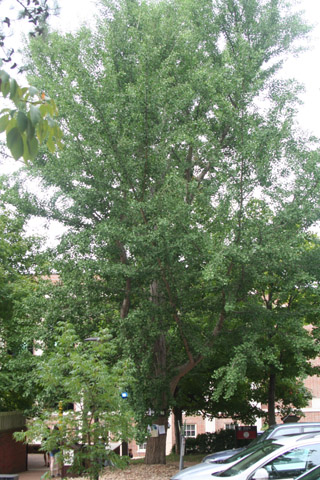
|

|

|

|
An individual instance of Ginkgo biloba (maidenhair tree)

Permanent unique identifier for this particular organism:
http://bioimages.vanderbilt.edu/vanderbilt/12-126
Notes:
This tree is at the entrance to the pedestrian bridge over 21st Ave. S. If you are taking the Peabody tree tour, this is the last tree on the tour. From here you can either continue on to begin the Main Campus tree tour by walking onto the pedestrian bridge, or you can cross Edgehill Avenue and travel north along 21st Ave. S. until you reach the Wesley Place parking garage (the starting point of the tour). From that point you can go to the first tree of the Peabody tree tour if you want.
Although ginkgo is not native to Tennessee, it is a unique and distinctive tree. It is unusual because it is a gymnosperm with broad deciduous leaves. (Most gymnosperms have evergreen needles). The fan shaped leaves are unmistakable with their repeatedly dividing veins. They are often notched at the tip. From a distance, the leaves make the branches look like large pipe cleaners. The bark of large trees is also distinctive with deep furrows and ridges.
Ginkgo is dioecious and the tree in front of you is a male. Most of the year, both sexes look the same. However, in the spring, the male produces cones that look different from the receptive female cones (which eventually develop into the fruit-like mature female cones). These mature cones stink and for that reason, most female trees are cut down as soon as they are old enough for the owner to discover their sex.
Ginkgos were thought to be extinct until they were discovered growing in China in the last century. They are now widely planted in cities and towns.
Although ginkgo is not native to Tennessee, it is a unique and distinctive tree. It is unusual because it is a gymnosperm with broad deciduous leaves. (Most gymnosperms have evergreen needles). The fan shaped leaves are unmistakable with their repeatedly dividing veins. They are often notched at the tip. From a distance, the leaves make the branches look like large pipe cleaners. The bark of large trees is also distinctive with deep furrows and ridges.
Ginkgo is dioecious and the tree in front of you is a male. Most of the year, both sexes look the same. However, in the spring, the male produces cones that look different from the receptive female cones (which eventually develop into the fruit-like mature female cones). These mature cones stink and for that reason, most female trees are cut down as soon as they are old enough for the owner to discover their sex.
Ginkgos were thought to be extinct until they were discovered growing in China in the last century. They are now widely planted in cities and towns.

|

|
|
Load database and switch to thumbnail view
Use this stable URL to link to this page:
http://bioimages.vanderbilt.edu/vanderbilt/12-126.htm
This organism is a living specimen that is part of the Vanderbilt University Arboretum with the local identifier 1-329.
This particular organism is believed to have managed means of establishment.
This organismal entity has the scope: multicellular organism.
Identifications:
Ginkgo biloba
L.
sec. fna.org 1993
common name: maidenhair tree
family: Ginkgoaceae
Identified 2002-04-10 by Steven J. Baskauf
Location:
Vanderbilt University, Nashville, Davidson County, Tennessee, US
Click on these geocoordinates to load a map showing the location: 36.14395°, -86.79912°
Coordinate uncertainty about: 10 m.
Location of individual determined from GIS database.
Occurrences were recorded for this particular organism on the following dates:
2002-04-10
2002-04-15
2014-09-11
The following images document this particular organism.
Click on a thumbnail to view the image and its metadata. Load database and enable navigation by taxon and organism.
| Image | View |

|
whole tree - general |

|
twig - showing attachment of needles |

|
twig - showing attachment of needles |

|
leaf - showing orientation on twig |

|
cone - male |